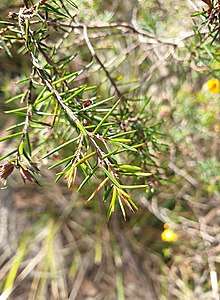Pultenaea juniperina
Pultenaea juniperina, known by the common names prickly beauty[1] and prickly bush-pea,[2] is a native Australian plant belonging to the family Fabaceae. Taking the form of a spiky shrub up to 1.5 m tall with abundant yellow-orange pea flowers typical of Fabaceae,[3] P. juniperina is widespread across southeast Australia, particularly present in southeast Victoria and across Tasmania.[4]
| Pultenaea juniperina | |
|---|---|
| Flowers and leaves, Big River State Forest, Victoria | |
| Scientific classification | |
| Kingdom: | |
| (unranked): | |
| (unranked): | |
| (unranked): | |
| Order: | |
| Family: | |
| Genus: | |
| Species: | P. juniperina |
| Binomial name | |
| Pultenaea juniperina | |
Taxonomy
Family
P. juniperina is a plant classified in the family Fabaceae, sometimes known as Lguminosae or simply the legume, bean or pea family. This family is large and widely distributed with 751 genera and approximately 19,000 known species encompassing trees and shrubs as well as perennial and annual herbaceous plants.
Genus
P. juniperina belongs to the genus Pultenaea known commonly as the bush peas and named after British physician and botanist Richard Pultney (1730-1801)[5]
Species
The specific name juniperina means juniper like, and is attributed to the species to its spiky foliage resembling that of a juniper plant.[5]
Subspecies
P. juniperina has been classified into several subspecies including the following:[6]
- var. juniperina Labill.
- var. latifolia
- var. leiocalyx
- var. mucronata
- var. planifolia
- var. uniflora


Morphology
Habit/stems
An erect shrub growing to over 1 m in height with a highly branched habit,[7] stems terete exhibiting hairs when young which range from spreading to curled.[3]
Leaves
Leaf dimensions range from 5–30 mm long and 1.5–2.5 mm wide, and are observed to be simple, alternate and evergreen. Their shape is highly variable,[7] commonly occurring as linear, narrow elliptic or narrow obovate but always exhibiting a spiky aristate apex.[6] Leaf margins are flat to recurved, with the abaxial (lower) surface a darker shade than the adaxial (upper) surface. Leaf blades occur at right angles to the petiole,[6] which is short and appressed to the stem, with pointed, soft, brown stipules occurring at the leaf base.[8]
Pods
The species exhibits hairy pods 6-8 mm in length, turgid, with lower half enclosed by calyx.
Flowering
P. juniperina exhibits characteristic pea flowers typical of the family Fabaceae, which are yellow to orange, often with darker reddish markings.[2] Flowers are axillary,[6] occurring on short lateral branches and ranging from terminal to apparently terminal, often clustered.[3] Flowers are 7–13 mm long with 2–3 mm pedicels and glabrous to glabrescent sepals 4–7 mm in length, usually fused. Bracts are approximately 2 mm long, 2–3 lobed, ovate, subulate, keeled, persistent and glabrous. Bracteoles vary from 1.5–3 mm in length and are ovate to lanceolate in shape. They lack stipules and are ovate, acuminate, hairy and attached at the base of the calyx tube. Lobes acuminate to acute with ciliate margins, and ovaries visibly hairy.[3]
Variation
It has long been known that there is a great deal of diversity within P. juniperina, with the species being divided into several subspecies.[6] These include var. uniflora and var. forsythiana identified by the National Herbarium of New South Wales[9] var. planifolia, described by H. B. Williamson in "A revision of the genus Pultenaea, Part II",[10] and var. mucronata which is considered its own species in Victoria named Pultenaea forsythiana. The variation in P. juniperina is predominantly exhibited in differing leaf characteristics as identified by prominent Tasmanian botanist Winifred Curtis in her 1942 paper "Variations in Pultenaea juniperina Labill". The wide-leaved P. juniperina variant latifolia, distinguished by nineteenth-century English botanist George Bentham, is used by Curtis to illustrate the range of leaf morphologies observed within the species.
Distribution

P. juniperina is native to southeast Australia and found in New South Wales, Victoria and Tasmania. In Victoria the species occurs in heathland and heathy understorey in the wet forests of the Grampians as well as a disjunct population near Tonumbuk.[3] In New South Wales it predominantly occurs in wet Eucalypt forests with sandy soil on granite in the far east.[6] Tasmania exhibits extensive populations across the state in both dry and wet Eucalypt forests.[4]
Ecology
Generally P. juniperina operates as a key understorey species in both wet and dry eucalypt forests.[11][6] The species also plays a significant role in ecosystem nutrient cycling, as it is a known "nitrogen fixer". Nitrogen fixing plants such as P. juniperina form symbiotic relationships with microorganisms in their roots, which operate to convert nitrogen into forms which can be utilized by the plant.[12]
References
- "Key to Tasmanian Dicots". utas.edu.au.
- "Prickly Bush-pea - profile". environment.nsw.gov.au.
- "Flora of Victoria". vicflora.rbg.vic.gov.au.
- "Occurrence records, Pultenaea juniperina". biocache.ala.org.au.
- "Taxandria juniperina, Agonis juniperina - Growing Native Plants". anbg.gov.au.
- "Pultenaea juniperina Labill". plantnet.rbgsyd.nsw.gov.au.
- Curtis, Winifred M. (25 November 1942). "Variations III Pultenaea juniperina Labill" (PDF).
- "Species information: Pultenaea juniperina". utas.edu.au.
- "Pultenaea forsythiana var. uniflora Blakely". biodiversity.org.au.
- "Pultenaea juniperina var. planifolia". biodiversity.org.au.
- "Forest Communities". The Valley Wilderness Retreat.
- Alfrey, Paul (25 July 2014). "Nitrogen Fixing Plants & Microbes". Permaculture Magazine.